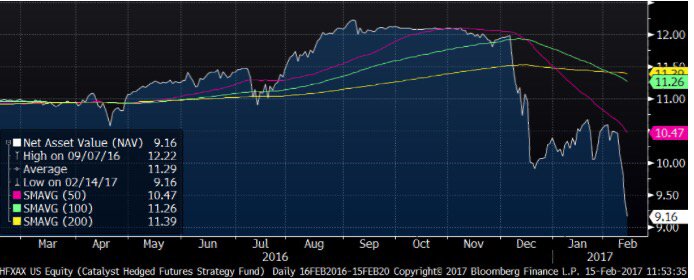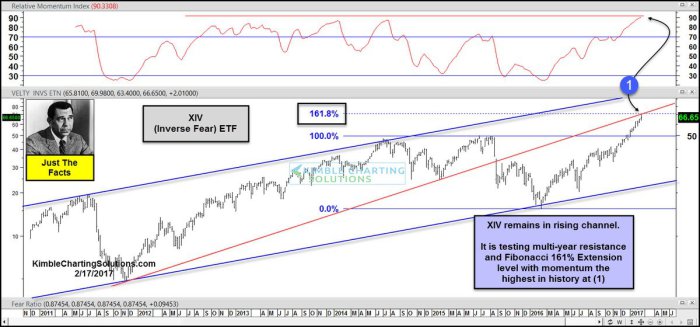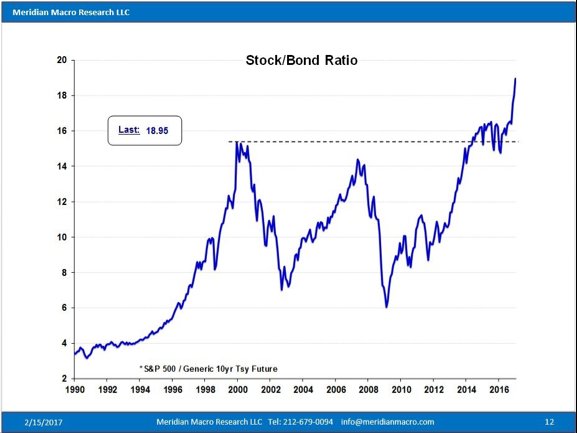Summary – A top-down review of interesting calls and comments made last week in Treasuries, monetary policy, economics, stocks, bonds & commodities. TAC is our acronym for Tweets, Articles, & Clips – our basic inputs for this article.
Editor’s Note: In this series of articles, we include important or interesting Tweets, Articles, Video Clips with our comments. This is an article that expresses our personal opinions about comments made on Television, Tweeter, and in Print. It is NOT intended to provide any investment advice of any type whatsoever. No one should base any investing decisions or conclusions based on anything written in or inferred from this article. Macro Viewpoints & its affiliates expressly disclaim all liability in respect to actions taken based on any or all of the information in this article. Investing is a serious matter and all investment decisions should only be taken after a detailed discussion with your investment advisor and should be subject to your objectives, suitability requirements and risk tolerance.
1. Vertical?
Remember how fast the Dow went from 19,000 to 21,000? In 42 days. By that speed, it should have taken 25 days for the Dow to climb from 20,000 to 20,600. Instead, it took 7 days, from Thursday, February 9 to Wednesday, February 15. True to form, this steep rally of 570 Dow points & 55 S&P handles rose after commitments from President Trump & in spite of a hard up move in interest rates. This move was so powerful that it felt as if we could hit 21,000 in just a few (defined by Webster as less than or equal to 8) more days. It felt like a buying panic.
The power of this move seemed to have peaked on this Wednesday’s close and interest rates also peaked for the week on Wednesday’s close.
What might have led to this explosion was apparently known to many, except of course to Fin TV reporters. The RBC report was first revealed by Zero Hedge. Then Fin TV picked it up on Thursday.
- Longconvexity
@LONGCONVEXITY – Catalyst Hedged Futures Strategy$HFXAX#IWillNotSellSPCalls$SPY$VIX
 Reportedly, a Catalyst fund was caught in loss-creating one-X-many S&P call spreads position. When the S&P blew through 2,300, the fund simply had to close the positions and hence the buying panic early this week. Catalyst reportedly announced on Thursday that they had closed these positions. That may be why the buy momentum stopped cold on Thursday morning.
Reportedly, a Catalyst fund was caught in loss-creating one-X-many S&P call spreads position. When the S&P blew through 2,300, the fund simply had to close the positions and hence the buying panic early this week. Catalyst reportedly announced on Thursday that they had closed these positions. That may be why the buy momentum stopped cold on Thursday morning.
2. Catalyst-Risk Parity-China decline
The best comment about the Catalyst effect came from Mark Yusko of Morgan Creek Capital on BTV on Friday in response to a BTV anchor’s description of Catalyst as a “whale” – “If a $3.4 billion fund is a whale, I want to go to cash“.
If a $3.4 billion fund can create such a problem, what does it say about liquidity conditions asked Mr. Yusko. Yusko compared this turbulence to China-triggered problems of Risk Parity funds in August 2015. When one risk parity fund had to liquidate, other risk parity funds had to follow. Yusko added that it is not just this Catalyst fund but other large pension funds are doing similar trades and wondered if they might be forced to liquidate as well.
The China-triggered Risk-Parity-led decline & the resultant spike in $VIX were brought up by Tom McClellan in his article VIX Futures Traders Finally Getting Complacent:
- “Something different is happening now. The current far-month contract is Oct. 2017, which closed on Feb. 15 at 17.675. That is the lowest number for the highest VIX futures contract since August 2015, just before the China-fueled mini-crash“.
- “Here is a chart showing that same plot of the highest priced VIX futures contract, this time compared to the share price of XIV. Notice that when the plot of the highest priced VIX futures contract (inverted) gets up this high, that is not a good time to be invested in XIV, and the risk of a big move downward increases in a big way.”
A similar concern about XIV was voiced by Chris Kimble:
- Chris Kimble
@KimbleCharting – Fear Indicator hitting levels never seen before, Says Joe Friday$VIX$XIV$SPX https://www.kimblechartingsolutions.com/2017/02/fear-indicator-hitting-highest-levels-history-says-joe-friday/ …
Marko Kolanovic of JP Morgan voiced a similar concern about a potential accident in the stock market arguing that correlations have dropped to historical lows & are likely to move up with a bounce in volatility. He said this is likely to begin in March and the onset of Quarterly Expiration cycle.
3. Inflation, Economy, S&P Targets
There is virtual consensus in the markets that reflation-inflation is on the way. Jim Paulsen of Wells Capital said on CNBC Squawk Box on Friday that this year reminds him of 1987. He said he sees stocks going up and rates going up. His target is 2,600 and he made the mandatory statement that we will not see a 1987 style drop after that.
On the other hand, Priya Mishra, a TD Securities & an ex-Merrill strategist, said the 10-year yield was in a range now and if the 10-year yield breaks 2.50% to the upside, we should buy the 10-year Treasury. But she sees inflation rising and her highest-conviction trade – Buy breakevens.
But another ex-Merrill economist has been pooh-poohing this inflation-schminflation stuff for some time and did it again this week – “I just cannot get too excited over the reflation-turn-inflation trade“. This week he got support from another:
- Ian Shepherdson @IanShepherdson – Feb 15 – I’ve been bearish about inflation, but even after Jan’s m/m core jump, the y/y rate is just back at the 2.3% pace first hit Feb last year.
But what about the strength of the data in various surveys?
- David Rosenberg – Some of the business surveys have gotten so bulled up that we have the Philly Fed index behaving as though real GDP growth is north of 8%
When have surveys run so ahead of actuality and what tends to happen then?
- Bill Hester, CFA
@billhester – S&P 500 – arrows show when survey surprise data runs ahead of hard data. 4/5
 The other 4 tweets of Mr. Hester are also interesting. Mark Yusko, despite the animal spirit seen in surveys, pointed out that the consumer is struggling and the economy is slowing right now. But his target for the bubble to end is 2,800 by labor day.
The other 4 tweets of Mr. Hester are also interesting. Mark Yusko, despite the animal spirit seen in surveys, pointed out that the consumer is struggling and the economy is slowing right now. But his target for the bubble to end is 2,800 by labor day.
4. Interest Rates
Priya Mishra proved right this week in her statement that 10-year Treasuries should be bought if the 10-year yield crosses 2.50%. It did on Wednesday thanks to Chair Yellen’s testimony on Tuesday & Wednesday. Then it fell on Thursday & Friday to close at 2.42%.
- Lawrence McDonald
@Convertbond – U.S. 10 Year Treasuries This Week: 2.53% to 2.39% Powerful secular forces continue to overpower the Street’s highly hyped Reflation trade
What are some of these secular forces?
- Lawrence McDonald
@Convertbond – Auto loan securitization data. Middle America is highly levereded, over-taxed, over-regulated with falling net income levels
Chair Yellen has to be frustrated. After she did so much to get yields up with her March rate hike discussion, the 5-year yield fell 9 bps from Wednesday’s close to Friday’s close. The entire 10-3 year curve fell in yield by 8-9 bps with the 2-year yield falling by 6 bps.
What could move both rates & stocks up? The State of the Union address of President Trump on February 28.
5. Stocks
That State of the Union speech was emphasized by Kevin O”Leary on CNBC FM 1/2 on Friday. He said he needs to hear serious calls on 2/28 to stay long financials. But his final verdict was – “I really like the markets. I am staying long.”
Rick Santelli did his white board stuff on Friday and showed how he gets to a Dow 21,576 target by March 6, 2017. It was an interesting technical exercise. But CNBC decided to expunge it from their website. Guess they don’t like Santelli to show his technician skills.
March 6 is two weeks from this Friday, right!
- Ryan Detrick, CMT
@RyanDetrick – Interesting stat – the past 20 times the#SPX was up 4 weeks in a row, it was higher 16 of those times two weeks later.#momentum
But what sector might drive the next leg?
- Ryan Detrick, CMT @RyanDetrick – Tech is nearing a picture perfect saucer bottom breakout relative to the #SPX. 16 years in the works … https://lplresearch.com/2017/0
2/15/the-nasdaq-just-did-somet hing-it-last-did-in-1999-time- to-worry/ …
 To be boring, the statement by Lawrence McMillan of Option Strategist summarizes the basic & so far correct posture:
To be boring, the statement by Lawrence McMillan of Option Strategist summarizes the basic & so far correct posture:
- “So, the market is overbought. That is not a reason to sell. As long as $SPX remains above support [2300] and $VIX remains below resistance [15], we remain intermediate-term bullish”.
6. Gold
- HedgeMind @HedgeMind – $GLD $GDX John Burbank of Passport is betting HUGE on Gold; acquired 5mln $GLD units & 9.15mln $GDX units, a move contrary to his peers.
Is Gold cheap?
- BGASC.com @BGASC_Metals – Feb 15 –Money managers no longer hate #gold, saying it’s undervalued http://www.marketwatch.com/sto
ry/money-managers-no-longer-ha te-gold-saying-its-undervalued -2017-02-15
- The latest survey of nearly 200 money managers worldwide [latest Bank of America Merrill Lynch monthly global fund manager survey], controlling more than half a trillion dollars in investment assets, shows a sudden and rare burst of bullishness about the yellow metal.
- They’re worried about inflation, stagflation and global protectionism, and they think gold is the best insurance against all three. And at less than $1,300 an ounce, they also think, for only the third time in a decade, that it is undervalued
- Only three times in the past 10 years has a majority believed gold was cheap. After the past two times — January 2009 and January 2015 — gold subsequently shot up in price
The conclusion might prove correct but to base it on a sample size of two?
7. Oil
Some said this week that oil price is destined to rally this year. It may indeed, but shouldn’t the charts below change direction for that?
- Jesse Felder
@jessefelder – New record high in crude oil inventories via@SoberLook
 8. Still think it is a German Nazi symbol?
8. Still think it is a German Nazi symbol?
 We appreciate the tweet & the photo but really wish that, some day, Indians stop being BrIndians & revert back to correct phonetic spellings.
We appreciate the tweet & the photo but really wish that, some day, Indians stop being BrIndians & revert back to correct phonetic spellings.
The “k” suffix in Samskrut means generator of or creator of. So Svasti-k means the generator of Svasti. The term Svasti is also a compound Samskrut term Su+Asti meaning a state (asti) of Great Good (for want of a better inclusive term). How is the state of Svasti described in ancient Samskrut literature?
- “Let all humanity be happily content. Let all humanity be without ill-health. Let all humanity perceive the Noble. Let no one suffer grief or pain.”*
 – A swastika composed of Hebrew letters as a mystical symbol from the Jewish Kabbalistic work “Parashat Eliezer.”
– A swastika composed of Hebrew letters as a mystical symbol from the Jewish Kabbalistic work “Parashat Eliezer.”
And what about today’s Jewish authorities?
Read Affirmation 7 of the Declaration of the joint Hindu-Jewish Leadership Summit in Jerusalem in 2008 under the stamp of the Chief Rabbinate of Israel and the World Council of Religious Leaders:
- “Svastika is an ancient and greatly auspicious symbol of the Hindu tradition. It is inscribed on Hindu temples, ritual altars, entrances, and even account books. A distorted version of this sacred symbol was misappropriated by the Third Reich in Germany, and abused as an emblem under which heinous crimes were perpetrated against humanity, particularly the Jewish people, The participants recognize that this symbol is, and has been sacred to Hindus for millennia, long before its misappropriation”
This is fine but why do Hindus keep using the British-imposed “w” & wrong suffix “a”? Because Indians became physically free in 1947 but remain mentally subservient to the British. Sad!
*Shaanti-Mantra of UpaNiSad – सर्वेऽपि सुखिन: सन्तु; सर्वे सन्तु निरामयाः; सर्वे भद्राणि पश्यन्तु; मा कश्चित् दुक्खम् आप्नुयात्
Send your feedback to editor@macroviewpoints.com Or @MacroViewpoints on Twitter



